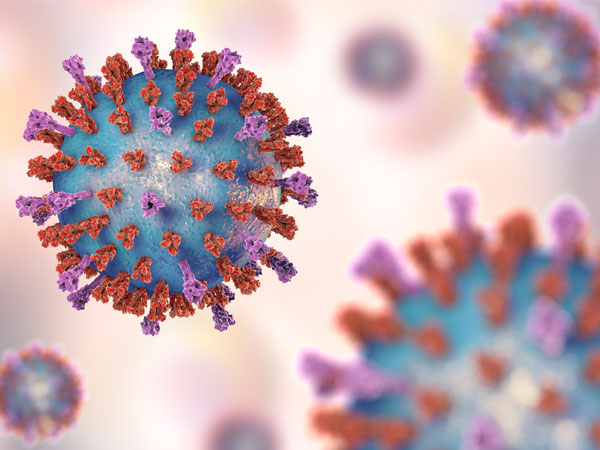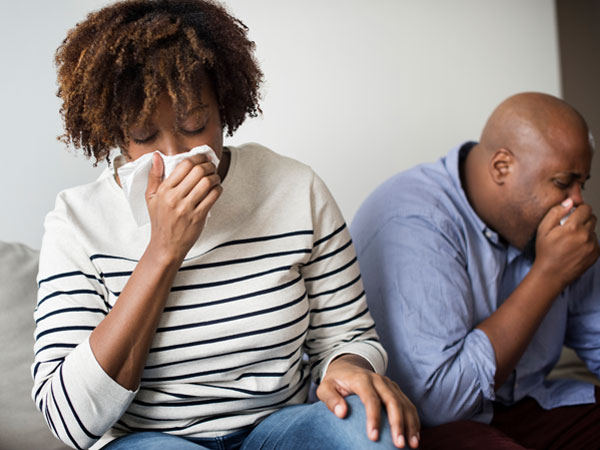- Home
- Science
- Diseases & Conditions
- Respiratory Syncytial Virus (RSV)
What Is Respiratory Syncytial Virus (RSV)?
Respiratory syncytial virus (RSV) is a virus that can cause an infection in the lungs and airways (breathing passages), producing symptoms that are often similar to a mild cold.1,2 People with RSV infection typically experience upper respiratory and lung-related symptoms, such as cough, wheezing, sneezing, runny nose, and/or fever. They may also lose their appetite.2
People of all ages can contract RSV more than once throughout their lifetimes.3 While the typical recovery from RSV is one to two weeks, it can present serious health risks for people within certain age ranges or with certain pre-existing conditions.1,2
By age 2, nearly all children have had RSV at least once.1,3 Among children under the age of 1, including newborn infants, RSV is the leading cause of pneumonia and bronchiolitis, which is inflammation of the lung’s small airways.1,2 Premature infants, children with congenital heart disease, and children with lung issues face a heightened risk of complications from RSV.1,2
RSV also presents heightened health risks for certain adults, particularly older adults and those with compromised immune systems or who have chronic heart or lung disease.4
Prevalence of Respiratory Syncytial Virus (RSV)
Respiratory syncytial virus (RSV) can infect people of all ages, from infants to older adults.2
- Prevalence of Respiratory Syncytial Virus (RSV) Among Children
Each year, about 58,000 to 80,000 children under the age of 5 are hospitalized with RSV.5,6 Among children under the age of 1, RSV is the leading cause of pneumonia and bronchiolitis, which is the inflammation of the lung’s small airways.1,2
RSV results in 2.1 million doctor visits for children under the age of 5 annually.5,6 By age 2, nearly all children have had RSV at least once.1,3
- Prevalence of Respiratory Syncytial Virus (RSV) Among Older Adults
The Centers for Disease Control and Prevention (CDC) estimates that RSV infection leads to an estimated 60,000 to 160,000 hospitalizations in adults ages 65 and older each year and that RSV infection causes an estimated 6,000 to 10,000 deaths in that population annually.5,6
Experts believe the precise disease burden is higher among all ages, as RSV cases tend to be underreported.5
Disparities in Respiratory Syncytial Virus (RSV) Infection
Research suggests that RSV affects certain racial and ethnic groups more than others. In 2022, after 10 years of documented worsening disparities between children of various ethnicities, researchers found peak RSV incidence for Black and Hispanic children to be two to three times higher than the rate in white children.7
RSV disparities also exist among socioeconomic groups. A 2022 study, for instance, found that infants in several states were more likely to be hospitalized with RSV if they were from low-income households.8
Causes and Risk Factors
What Causes Respiratory Syncytial Virus (RSV)?

Respiratory syncytial virus (RSV) is a virus that impacts the airways, lungs, throat, and/or nose, resulting in symptoms that range from mild to severe.5 RSV tends to be a seasonal illness. Infection rates typically start to build in the fall and peak in the winter, but timing and severity can differ depending on the year and geography.3
People infected with the virus may be contagious for a period of time between three and eight days. Those with the virus may be contagious for one to two days before symptoms emerge. People with weakened immune systems may be contagious for up to four weeks, even if symptoms disappear.3
RSV spreads in several ways:3
- Surface contact: RSV survives for hours on nonporous surfaces. When a person touches a contaminated surface and then touches their face, they may become infected with RSV.
- Coughs and sneezes: When an infected person coughs or sneezes, viral particles become airborne and may infect others.
- Droplets: When bodily fluid from an infected person enters another person’s mouth, eyes, or nose, it can lead to infection.
- Direct contact: The virus can spread through touching or close contact, such as kissing a child who is infected.
Children typically catch RSV at school or day care and then bring it home to their families.3,9,10
Preventing Respiratory Syncytial Virus (RSV) Infection
The CDC recommends several steps people can take to minimize the risk of transmitting or contracting RSV. Some examples include:11
- Cleaning high-touch surfaces frequently.
- Using a tissue or shirt sleeve to cover sneezes and coughs.
- Avoiding shaking hands, sharing utensils, kissing, and other types of close contact.
- Practicing good hand hygiene by washing with soap and water for 20 seconds or more.
When experiencing RSV symptoms, avoid interacting with at-risk children. If it’s impossible to avoid interacting with kids, the CDC precautions are recommended. Finally, according to experts, parents of at-risk children should:9,10
- Minimize the time the child spends in high-transmission areas, such as day care.9,10
- Keep the child away from sick people.11
- Encourage the child to wash their hands and avoid touching their face.11
- Wash the child’s hands for them with soap and water for 20 seconds or more.11
Furthermore, RSV vaccines can provide some level of protection for people in certain groups.
- Healthcare providers may recommend RSV vaccination for adults age 60 and older, who are more at risk for serious illness as a result of declining immune system function.11
- Pregnant individuals may also choose to become vaccinated, especially during RSV season (fall through winter). Doing so may help prevent illness related to RSV in infants up to 6 months old.12
Alongside vaccination, healthcare providers may recommend other preventive therapies. For example, some children who are at increased risk for severe disease may be prescribed monoclonal antibody treatment.11,13 Usually given as injections, monoclonal antibodies are lab-grown immune system proteins that target certain viruses and diseases and may help prevent or manage symptoms of illnesses like RSV.11,14
Lastly, having RSV once doesn’t give you permanent immunity. You can contract RSV infections multiple times throughout your lifetime.3
Symptoms of Respiratory Syncytial Virus (RSV) Infection
People typically develop symptoms four to six days after becoming infected with RSV. Symptoms tend to include runny nose, loss of appetite, coughing, wheezing, sneezing, and fever. Young infants may have trouble breathing, be irritable, or become less active.2

Potential Complications from Respiratory Syncytial Virus (RSV) Infection

For most people, RSV is a mild, cold-like illness and resolves within one to two weeks.1,2
RSV can be particularly serious for certain groups, including older adults, people with underlying health conditions, premature and very young infants, and children with congenital heart disease or chronic lung disease.1,4 Infection can lead to complications such as bronchiolitis (inflammation of the lung’s small airways) and pneumonia.1,2
Children under 6 months of age and older adults may need to be hospitalized if they struggle to breathe or stay hydrated.2 In newborns, urinary tract infections may accompany bronchiolitis stemming from RSV.15 Therefore, very sick infants may require urine or blood tests to confirm the cause of illness.15
When a person has a severe RSV infection, they may need a breathing tube connected to a breathing machine (mechanical ventilation), intravenous (IV) fluids if they are dehydrated, and/or oxygen therapy.2
People hospitalized with RSV typically return home after a few days of care.2
Diagnosis and Treatment
Respiratory Syncytial Virus (RSV) Diagnosis
For suspected RSV cases, healthcare providers may obtain a full medical history and conduct a physical exam. They may also consider the time of year when the patient began showing symptoms, as RSV infections tend to follow seasonal cycles.3,15
Healthcare providers who suspect RSV infection may also run lab tests, such as a mouth swab or a blood test. These tests identify discrepancies in blood counts, as elevated white blood cell counts may reveal the presence of viral or bacterial infection. Healthcare professionals may also order a chest X-ray or a CT (computed tomography) scan.15,16
Respiratory Syncytial Virus (RSV) Treatment
Respiratory syncytial virus (RSV) treatment often involves self-care that is administered at home. For example, a healthcare provider may recommend drinking extra fluids or using over-the-counter medications to manage fever.2
People at high risk, including older adults, young children, and people with chronic health conditions, may face more severe illness from RSV infection. They may require hospital-based care to treat bronchiolitis, pneumonia, or dehydration or to address difficulty breathing.1,2
Global Impact of Respiratory Syncytial Virus (RSV)

Around the world, an estimated 64 million people of all ages contract RSV each year, leading to about 160,000 deaths.1
A 2022 study found that RSV causes one in 50 deaths in children aged <1 month. According to the same study, one in every 28 deaths results from RSV infection among children between 28 days and 6 months old.17
Globally, many people with severe RSV illness never make it to a hospital. In the 2022 study, researchers estimated that, for every RSV-linked death in a hospital, there are three more in the community.17
Frequently Asked Questions About Respiratory Syncytial Virus (RSV)
- What are RSV symptoms?
Regardless of age, people who have been infected with RSV typically have upper respiratory symptoms, such as cough, sneezing, wheezing, and a runny nose. They may also have a fever and a smaller appetite. These symptoms typically emerge in stages rather than at the same time.2
Young infants may experience additional symptoms, which include breathing trouble, irritability, and lethargy.2
- What are RSV symptoms in adults?
In adults, RSV symptoms typically resemble a cold. Infected individuals may experience a headache, runny nose, cough, or sore throat. These symptoms can lead to hospitalization if a person is at risk for severe RSV illness. This includes older adults, people with chronic heart or lung disease, and people with weakened immune systems.1,2,4
- Can adults get RSV?
RSV can infect anyone—even adults—but certain groups face greater health risks. Vulnerable people include older adults, children born prematurely or with congenital heart disease, children with lung issues, and very young infants.1,2,4
- How long is RSV contagious?
People who contract RSV are typically contagious for three to eight days after the initial infection. They may begin spreading the virus one to two days before symptoms emerge. People with immune system issues may spread the virus for up to four weeks, even after symptoms go away.3
- When do RSV infections typically happen?
RSV tends to follow certain seasonal trends and may appear in certain geographical locations sooner than others.6 In most areas of the U.S., the number of RSV cases typically begins to increase in the fall and peaks in the winter. However, the timing and severity of RSV may change from one year to the next, depending on where a person lives.3
Learn More About Respiratory Syncytial Virus (RSV)
Find a Pfizer clinical trial for Respiratory Syncytial Virus (RSV) at PfizerClinicalTrials.com.
Explore Respiratory Syncytial Virus (RSV) clinical trials at ClinicalTrials.gov.
Area of Focus: Vaccines
Respiratory Syncytial Virus (RSV) is a focus of Pfizer’s Vaccines Therapeutic Area. Visit the Vaccines Page.
- References
- Respiratory syncytial virus (RSV). National Institute of Allergy and Infectious Diseases. https://www.niaid.nih.gov/diseases-conditions/respiratory-syncytial-virus-rsv. Updated July 22, 2022. Accessed February 21, 2024.
- About RSV. Respiratory syncytial virus infection (RSV). Centers for Disease Control and Prevention. https://www.cdc.gov/rsv/about/?CDC_AAref_Val=https://www.cdc.gov/rsv/about/symptoms.html. Updated August 16, 2023. Accessed February 21, 2024.
- How RSV Spreads. Centers for Disease Control and Prevention. https://www.cdc.gov/rsv/causes/?CDC_AAref_Val=https://www.cdc.gov/rsv/about/transmission.html. Updated November 1, 2022. Accessed February 21, 2024.
- RSV in adults. American Lung Association. https://www.lung.org/lung-health-diseases/lung-disease-lookup/rsv/rsv-in-adults. Updated January 9, 2023. Accessed February 21, 2024.
- Respiratory syncytial virus (RSV). National Foundation for Infectious Diseases. https://www.nfid.org/infectious-diseases/rsv/. Updated March 2022. Accessed February 21, 2024.
- Surveillance of RSV. Centers for Disease Control and Prevention. https://www.cdc.gov/rsv/php/surveillance/?CDC_AAref_Val=https://www.cdc.gov/rsv/research/index.html. Updated July 17, 2023. Accessed August 28, 2023. February 21, 2024.
- Wang L, Davis PB, Berger NA, Kaelber DC, Volkow ND, Xu R. Disruption in Seasonality, Patient Characteristics and Disparities of Respiratory Syncytial Virus Infection among Young Children in the US during and before the COVID-19 Pandemic: 2010-2022. Infectious Diseases (except HIV/AIDS); 2022.
- Zheng Z, Warren JL, Shapiro ED, Pitzer VE, Weinberger DM. Estimated incidence of respiratory hospitalizations attributable to RSV infections across age and socioeconomic groups. Pneumonia. 2022;14(1):6.
- Protecting Against COVID-19 and Other Infections in Early Care and Education Programs. Centers for Disease Control and Prevention. https://www.cdc.gov/early-care/prevention/protecting-against-covid-19-and-other-infections-in-early-care.... Updated November 14, 2022. Accessed February 27, 2024.
- Respiratory Syncytial Virus (RSV) Fact Sheet. Pennsylvania Department of Health. https://www.health.pa.gov/topics/Documents/Diseases%20and%20Conditions/RSV.pdf. October 2, 2023. Accessed February 27, 2024.
- RSV Vaccines. Centers for Disease Control and Prevention. https://www.cdc.gov/rsv/vaccines/?CDC_AAref_Val=https://www.cdc.gov/rsv/about/prevention.html. Updated January 18, 2024. Accessed February 21, 2024.
- FDA approves first vaccine for pregnant individuals to prevent RSV in infants. U.S. Food & Drug Administration. August 21, 2023. https://www.fda.gov/news-events/press-announcements/fda-approves-first-vaccine-pregnant-individuals-prevent.... Accessed February 21, 2024.
- Palivizumab injection. MedlinePlus. https://medlineplus.gov/druginfo/meds/a698034.html. Updated December 15, 2016. Accessed February 21, 2024.
- Monoclonal antibodies. National Cancer Institute. https://www.cancer.gov/about-cancer/treatment/types/immunotherapy/monoclonal-antibodies. Updated September 24, 2019. Accessed February 21, 2024.
- RSV symptoms and diagnosis. American Lung Association. https://www.lung.org/lung-health-diseases/lung-disease-lookup/rsv/symptoms-diagnosis. Updated March 7, 2023. Accessed February 21, 2024.
- White blood cell count. MedlinePlus. https://medlineplus.gov/lab-tests/white-blood-count-wbc/. Updated September 16, 2021. Accessed February 21, 2024.
- Li Y, Wang X, Blau DM, et al. Global, regional, and national disease burden estimates of acute lower respiratory infections due to respiratory syncytial virus in children younger than 5 years in 2019: A systematic analysis. The Lancet. 2022;399(10340):2047-2064.
The information contained on this page is provided for your general information only. It is not intended as a substitute for seeking medical advice from a healthcare provider. Pfizer is not in the business of providing medical advice and does not engage in the practice of medicine. Pfizer under no circumstances recommends particular treatments for specific individuals and in all cases recommends consulting a physician or healthcare center before pursuing any course of treatment.

